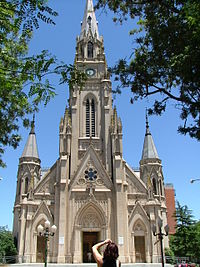Mercedes, Buenos Aires
| Mercedes | ||
|---|---|---|

Mercedes Cathedral, built in 1904 and
National Historic Monument since 2010. |
||
|
||
| Coordinates: 34°39′S 59°26′W / 34.650°S 59.433°WCoordinates: 34°39′S 59°26′W / 34.650°S 59.433°W | ||
| Country |
|
|
| Province |
|
|
| Partido | Mercedes | |
| Founded | June 25, 1752 | |
| Elevation | 38 m (125 ft) | |
| Population (2001 census [INDEC]) | ||
| • Total | 51,967 | |
| CPA Base | B 6600 | |
| Area code(s) | +54 02324 | |
Mercedes (Spanish pronunciation: [merˈseðes]) is a city in Buenos Aires Province, Argentina. It is located 100 km west from Buenos Aires and 30 km southwest of Luján. It is the administrative headquarters for the district (partido) of Mercedes as well as of the judicial district. The Catedral Basílica de Mercedes-Luján, located in the city, is the seat of the Roman Catholic Archdiocese of Mercedes-Luján.
Mercedes has a population of 51,967 people (51,5% women, 48,5% men) as per the 2001 census [INDEC].
Mercedes was first established as a fortress against native indigenous attacks. Its original name was "La Guardia de Luján" and it was one of several fortress built in the borders of Buenos Aires to protect this city and gather the people living in the county near.
It became a town on 25 June 1752 when founded by José de Zárate during a military campaign known as "La Valerosa". In 1777 viceroy Pedro de Cevallos proposed moving the town, but actually it was moved to its present location by viceroy Juan José de Vértiz on 8 May 1779. When moved its name was changed to "Nuestra Señora de las Mercedes".
Mercedes is one of the few towns in Argentina in which three different railways meet, thus been connected with large commercial areas as Buenos Aires as well as the Pacific Ocean, the Andes range and the pampas plains. This was a powerful reason during the 19th century for proposing the city as the capital of Buenos Aires Province. Finally La Plata became capital, but Mercedes became known as the "West Pearl".
...
Wikipedia

